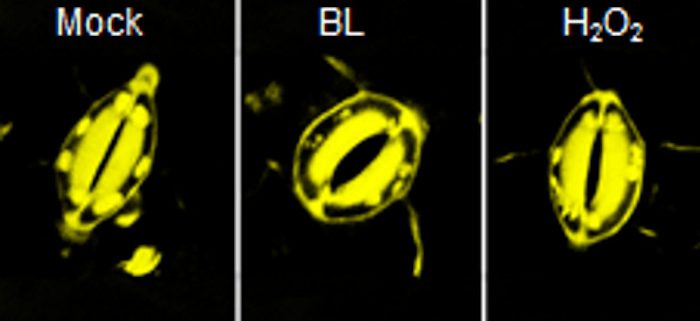Brassinosteroids and H2O2 Regulate Guard Cell Starch Metabolism
Li et al. demonstrate that the BR and H2O2 interdependently promote guard cell starch degradation and stomatal opening in Arabidopsis.
Plant Cell https://doi.org/10.1105/tpc.19.00587
By Jin-Ge Li, Min Fan, Wenbo Hua, Yanchen Tian, and Ming-Yi Bai
The Key Laboratory of Plant Development and Environmental Adaptation Biology, Ministry of Education, School of Life Science, Shandong University, 266237, Qingdao, China;
Background: Starch, the main storage carbohydrate in plants, can be synthesized and degraded as needed when plants face various environmental challenges. Guard cells are the epidermal structures that modulate gas exchange between plants and the atmosphere. Starch in guard cells is rapidly degraded within one hour of light exposure, providing the plant with organic acids and sugars and promoting stomatal opening. Brassinosteroids (BRs) are a group of plant steroid hormones that regulate a wide range of plant growth and developmental processes, and have been reported to promote stomatal opening. However, whether BR regulates starch metabolism in guard cells to control stomatal movement remains unclear.
Question: Do BRs and H2O2 affect stomatal opening by regulating the starch metabolism in guard cells? We tested this by measuring the starch granules and stomatal apertures in some BR- and H2O2-related plant materials from Arabidopsis.
Findings: We found that, when BR levels were low or absent, the guard cells had excess starch granules, the starch was not degraded in the light, and the stomatal apertures were small. In addition, we found that H2O2 induced guard cell starch degradation and promoted stomatal opening. Further, we found that BR and H2O2 depended on each other to induce the expression of β-amylase1 (BAM1), which can lead to starch degradation and stomatal opening.
Next steps: Based on these findings, we will examine how BR and H2O2 improve photosynthesis efficiency and balance plant growth and drought tolerance by regulating starch metabolism in guard cells. The knowledge gleaned will provide crop scientists with a theoretical basis for improving crop yields.
Jin-Ge Li, Min Fan, Wenbo Hua, Yanchen Tian, Lian-Ge Chen, Yu Sun, and Ming-Yi Bai (2020). Brassinosteroid and Hydrogen Peroxide Interdependently Induce Stomatal Opening by Promoting Guard Cell Starch Degradation. Plant Cell. DOI: https://doi.org/10.1105/tpc.19.00587.




